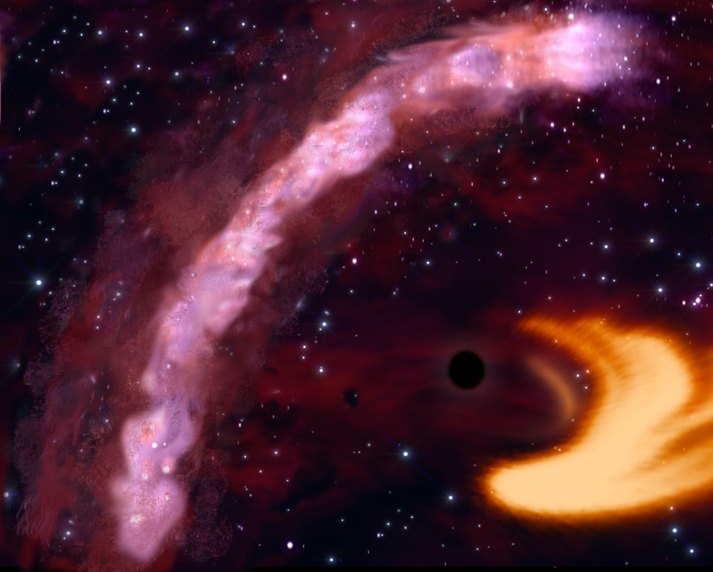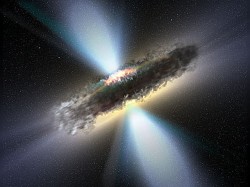The light echo of an X-ray flare from the nucleus of a galaxy has been observed. The flare almost certainly originates from a single star being gravitationally ripped apart by a supermassive black hole in the galactic core. As the star was being pulled into the black hole, its material was injected into the black hole accretion disk, causing a sudden burst of radiation. The resulting X-ray flare emission was observed as it hit local stellar gases, producing the light echo. This event gives us a better insight to how stars are eaten by supermassive black holes and provides a method to map the structure of galactic nuclei. Scientists now believe they have observational evidence for the elusive molecular torus that is thought to surround active supermassive black holes.
Light echoes from distant galaxies have been observed before. The echoes from a supernova that occurred 400 years ago (that is now observed as the supernova remnant SNR 0509-67.5) were only just observed here on Earth, after the supernova emissions bounced off galactic matter. This is the first time however that the energetic emissions from a sudden influx of matter into a supermassive black hole accretion disk has been observed echoing off gases within galactic nuclei. This is a major step toward understanding how stars are consumed by supermassive black holes. Additionally, the echo acts like a searchlight, highlighting the dark stellar matter between the stars, revealing a structure we have never seen before.
This new research was carried out by an international team led by Stefanie Komossa from the Max Planck Institute for extraterrestrial Physics in Garching, Germany, using data from the Sloan Digital Sky Survey. Komossa likens this observation to illuminating a dark city with a firework burst:
“To study the core of a normal galaxy is like looking at the New York skyline at night during a power failure: You can’t learn much about the buildings, roads and parks. The situation changes, for example, during a fireworks display. It’s exactly the same when a sudden burst of high-energy radiation illuminates a galaxy.” – Stefanie Komossa
A strong X-ray burst such as this can be very hard to observe as they are short-lived emissions, but a huge amount of information can be gained by seeing such an event if astronomers are quick enough. By analysing the degree of ionization and velocity data in the spectroscopic emission lines of the echoed light, the Max Planck physicists were able to deduce the flare location. Held within the emission lines are the cosmic “fingerprints” of the atoms at the source of the emission, leading them to the galactic core where a supermassive black hole is believed to live.
The standard model for galactic nuclei (a.k.a. unified model of active galaxies) predict a “molecular torus” surrounding the black hole accretion disk. These new observations of the galaxy named SDSSJ0952+2143 appear to show the X-ray flare was reflected by the galactic molecular torus (with strong iron emission lines). This is the first time the presence of a possible torus has been seen, and if confirmed, astrophysicists will have their observational evidence of this theoretical possibility, strengthening the standard model. What’s more, using accretion disk flares may aid scientists when attempting to map the structure of other molecular toruses.
Strengthening the observation of echoed X-ray emission from the torus is the possibility of seeing variable infrared emissions. This emission signifies a “last call for help” by the dusty cloud being rapidly heated by the incident X-rays. The dust will have been vaporized soon after.
But how do they know it was a star that fell into the accretion disk? In addition to the strong iron lines, there are strange hydrogen emission lines which have never been seen before. This is a strong piece of evidence that it is the debris from a star that came too close to the black hole, stripping away its hydrogen fuel.
Although the X-ray flare has subsided, the galaxy continues to be observed by the X-ray satellite Chandra. Faint but measurable X-ray emissions are being observed perhaps signifying that the star is still being fed to the accretion disk. It seems possible that measuring this faint emission may also be of use, allowing researchers to continue to map the molecular torus long after the initial strong X-ray emission has ended.
Sources: arXiv, Max Planck Institute for Extraterrestrial Physics



Another great example of the use of light echos as an observational tool. Great work!
To Astrofiend: Glad you enjoyed it. I too was totally blown away by this discovery. There will be more!
To Vanamonde: Thanks for pointing the error out – read “dust” instead of “gas”, it’s been corrected.
So in response: a) My mistake, and b) Not my quote – this was the terminology used by the Max Planck Institute scientists to describe the situation (check the source of the story: http://www.mpe.mpg.de/Highlights/PR20080416/text.html)
And thank you for the complement! I never considered myself a broadcast news journalist, I’m flattered…
Ian
PS. This might be too much anthropomorphic nonsense for you, but it is attached to some world-class research with some stunning implications. But then again, I’m sure you noticed that but chose to complain instead…
Cool pictures – our made them? They look like artwork to me. Great article, except for “This emission signifies a “last call for help” by the gases as they are rapidly heated by the incident X-rays. They are vaporized shortly after.” a) you can’t vaporized a gas! It is already vapor. Maybe that is “ionized”? I dunno. And, b) gases do not call anyone. That is the kind of
anthropomorphic nonsense I would except from a broadcast news journalist.